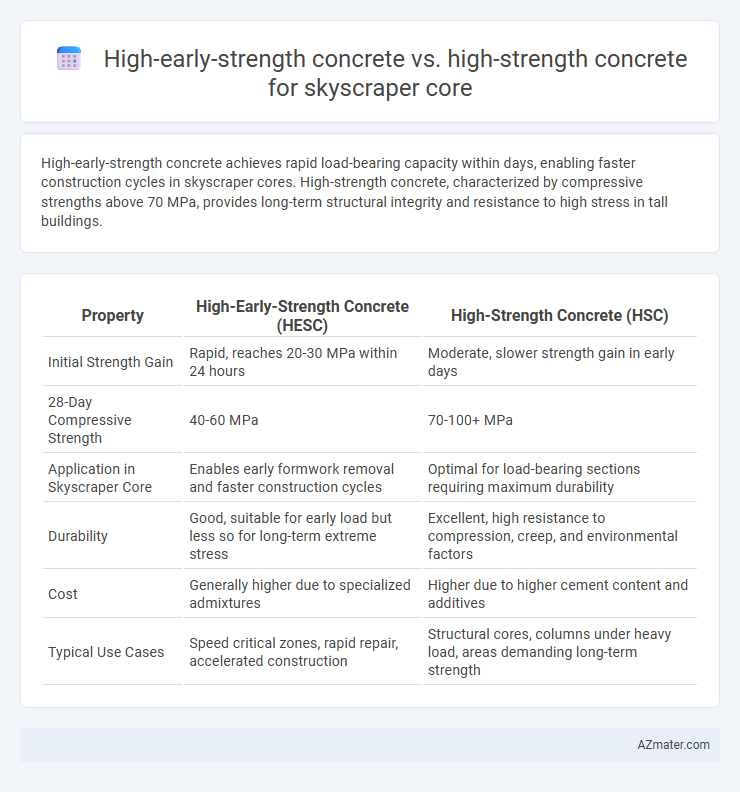High-early-strength concrete achieves rapid load-bearing capacity within days, enabling faster construction cycles in skyscraper cores. High-strength concrete, characterized by compressive strengths above 70 MPa, provides long-term structural integrity and resistance to high stress in tall buildings.
Table of Comparison
| Property | High-Early-Strength Concrete (HESC) | High-Strength Concrete (HSC) |
|---|---|---|
| Initial Strength Gain | Rapid, reaches 20-30 MPa within 24 hours | Moderate, slower strength gain in early days |
| 28-Day Compressive Strength | 40-60 MPa | 70-100+ MPa |
| Application in Skyscraper Core | Enables early formwork removal and faster construction cycles | Optimal for load-bearing sections requiring maximum durability |
| Durability | Good, suitable for early load but less so for long-term extreme stress | Excellent, high resistance to compression, creep, and environmental factors |
| Cost | Generally higher due to specialized admixtures | Higher due to higher cement content and additives |
| Typical Use Cases | Speed critical zones, rapid repair, accelerated construction | Structural cores, columns under heavy load, areas demanding long-term strength |
Introduction: Importance of Concrete Selection in Skyscraper Core Construction
Selecting the appropriate concrete type is critical for skyscraper core construction, where structural integrity and speed of construction are paramount. High-early-strength concrete accelerates formwork removal and load-bearing capacity development, supporting fast-paced project timelines. High-strength concrete provides superior long-term durability and load resistance essential for the core's role in overall building stability and safety.
Defining High-Early-Strength Concrete vs. High-Strength Concrete
High-early-strength concrete achieves compressive strength typically above 20 MPa within 24 hours, enabling faster construction cycles and early formwork removal in skyscraper cores. High-strength concrete, with compressive strength exceeding 50 MPa at 28 days, provides enhanced load-bearing capacity critical for structural integrity and resistance to lateral forces in tall buildings. The choice between them depends on project timeline priorities and performance requirements, balancing rapid strength gain against ultimate durability and strength.
Key Material Properties: Comparison Table
High-early-strength concrete achieves rapid strength gain, typically reaching 20-30 MPa within 24 hours, ideal for accelerating construction schedules in skyscraper cores, whereas high-strength concrete attains greater ultimate compressive strengths above 70 MPa, enhancing load-bearing capacity and durability over time. High-early-strength concrete exhibits higher early modulus of elasticity and reduced setting time but tends to have lower long-term toughness and slightly increased shrinkage compared to high-strength concrete. The selection between these concretes depends on balancing early construction speed against long-term structural performance, with key parameters including compressive strength development, modulus of elasticity, density, and shrinkage characteristics detailed in comparative material property tables.
Speed of Construction: Advantages and Trade-offs
High-early-strength concrete accelerates skyscraper core construction by achieving necessary load-bearing capacity within 24 to 48 hours, enabling faster formwork removal and quicker subsequent floor pours. High-strength concrete, while offering superior compressive strength above 8,000 psi for enhanced structural performance, typically requires longer curing times, slowing overall build speed. Choosing between the two involves balancing rapid construction needs against long-term structural demands and cost implications.
Structural Performance Requirements for Skyscraper Cores
High-early-strength concrete offers rapid strength gain essential for accelerated construction schedules in skyscraper cores, ensuring early load-bearing capacity and reducing formwork cycles. High-strength concrete provides superior compressive strength critical for supporting the immense vertical and lateral loads encountered in tall structures, enhancing overall core stability and durability. Structural performance requirements prioritize a balance between early load resistance and long-term strength to meet safety standards and optimize the skyscraper's core integrity.
Durability and Longevity Considerations
High-early-strength concrete accelerates construction schedules by achieving rapid strength gain, but it may exhibit increased shrinkage and reduced long-term durability compared to high-strength concrete, which offers enhanced compressive strength and superior resistance to environmental factors crucial for skyscraper core stability. High-strength concrete's dense microstructure minimizes permeability, reducing corrosion risk of embedded reinforcement and improving longevity under cyclic loads and aggressive urban environments. Selecting the appropriate concrete type balances early construction demands with the essential durability and lifespan requirements critical for skyscraper core performance.
Cost Analysis: Material, Labor, and Lifecycle
High-early-strength concrete accelerates construction schedules for skyscraper cores, reducing labor costs by enabling faster formwork removal and earlier subsequent work stages, though its material costs are typically higher due to specialized additives. High-strength concrete offers superior long-term structural performance with potentially lower material costs but may extend construction time, increasing labor expenses. Lifecycle analysis favors high-early-strength concrete for projects prioritizing rapid completion and cash flow, while high-strength concrete benefits designs emphasizing durability and reduced maintenance over the building's lifespan.
Construction Challenges and Mitigation Strategies
High-early-strength concrete accelerates the construction schedule of skyscraper cores by enabling faster formwork removal and earlier load application, but it often poses challenges such as increased shrinkage and potential cracking. High-strength concrete provides superior load-bearing capacity and durability for the core but requires careful mix design and quality control to avoid workability issues and delayed curing problems. Mitigation strategies include optimizing curing regimes, using shrinkage-reducing admixtures, and employing real-time monitoring systems to ensure structural integrity and minimize construction delays.
Case Studies: Successful Applications in Skyscraper Projects
High-early-strength concrete demonstrates rapid load-bearing capacity, enabling faster construction cycles in skyscraper cores, as evidenced by its use in the Shanghai Tower where construction speed increased by 30%. High-strength concrete, favored for its superior compressive strength exceeding 70 MPa, was pivotal in the Burj Khalifa, supporting immense vertical loads and enhancing structural stability. Case studies reveal that combining these concrete types optimizes core performance, balancing early formwork removal with long-term durability in iconic high-rise buildings.
Choosing the Right Concrete for Your Skyscraper Core
High-early-strength concrete gains strength rapidly, enabling faster construction and early formwork removal, making it ideal for speeding up the skyscraper core schedule. High-strength concrete delivers superior compressive strength and durability, crucial for supporting the massive vertical loads and ensuring long-term stability of tall structures. Selecting the right concrete depends on project timelines and structural demands, balancing early load capacity with ultimate strength requirements for optimal skyscraper core performance.

Infographic: High-early-strength concrete vs High-strength concrete for Skyscraper core
 azmater.com
azmater.com